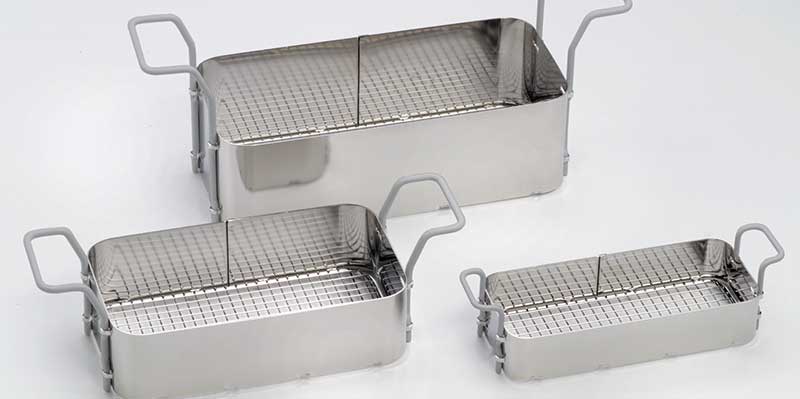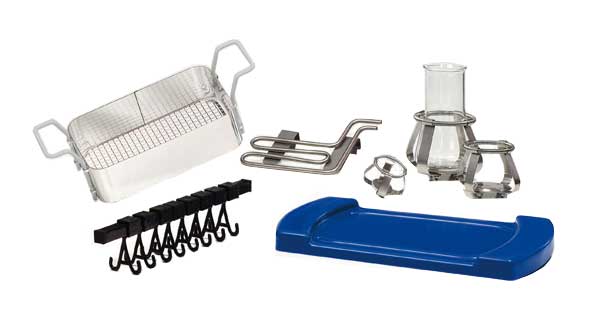
Ultrasonic Cleaner Parts Boost Cleaning Efficiency
Your investment in an ultrasonic cleaner pays dividends in terms of faster, more thorough cleaning enabling you to increase throughput in your business and, we hope, improve your profitability. In this post we describe how ultrasonic cleaner parts such as baskets and accessories contribute to your bottom line.
Overview of Ultrasonic Cleaner Parts
The objectives of your ultrasonic cleaning operations governs the parts you should have to accomplish the tasks. Here’s what we’ll cover in this overview:
- Baskets – do you need them and why?
- Alternatives to baskets
- Controlling noise and evaporation
- Managing cleaning solution temperatures
- Cleaning with highly acidic solutions
- Cleaning with volatile solvents
- Sample prep with an ultrasonic cleaner
Why Use a Basket for Ultrasonic Cleaning?
Cleaning baskets may be an optional accessory when buying an ultrasonic cleaner. That’s because many users may already have baskets. Ultrasonic cleaner parts baskets are needed for two major reasons:
- Parts baskets keep products being cleaned from contact with the bottom of the ultrasonic cleaner tank. Otherwise severe damage and eventual leaking will result due to vibrations.
- Parts baskets ensure cavitation (cleaning) action is maximized by holding products at the optimum level above the tank bottom. This is why different tank dimensions call for correct basket specifications.
Most ultrasonic cleaner parts baskets are designed with an open mesh bottom of sufficient strength to hold products being cleaned. That said, you should not overload your baskets – meaning do not stack products in an attempt to clean more at the same time. Best results are achieved when parts are not in contact with each other.
A variety of special ultrasonic cleaner parts accessories are available to handle special cleaning requirements. Examples include jewelry racks and racks to position printed circuit boards in the solution. Erlenmeyer flask holders are other examples.
If you clean very small parts, consider fine mesh immersion baskets that can be positioned in standard baskets or otherwise suspended in the cleaning solution. For another look at this see the section on cleaning with volatile solvents.
If you’re more visual, we invite you to view our video “Why use ultrasonic cleaner parts baskets?”
Alternatives to Ultrasonic Cleaning Baskets
If you clean very large parts an alternative is a mechanism to lower the part into the ultrasonic cleaning solution. Again exercise care to keep the part from contacting the bottom of the tank. Some tanks are designed with ridges fabricated on the bottom to hold these parts, thus freeing the raising and lowering mechanism for use elsewhere during your cleaning cycle.
Ultrasonic Cleaning Accessories to Reduce Noise and Cleaning Solution Evaporation
While the term “ultrasonic” is defined as sound above the range of human hearing (typically 20,000 cycles per second or 20 kHz) ultrasonic cleaners do make noise. This is caused by vibrations within the unit itself and parts being cleaned.
Cleaning at higher frequencies is less “noisy” than at lower frequencies. To reduce noise distraction:
- Place ultrasonic cleaners within sound insulating cabinets
- Use a lid that also helps reduce cleaning solution evaporation (see below)
- Equip staff with sound protecting earmuffs
Many benchtop ultrasonic cleaners are offered with lids that do double duty by serving as a drain tray after the cleaning cycle. This allows you to return drained solution to the cleaning tank. Larger industrial units may come with standard or insulated lids.
Ultrasonic Cleaning Accessories to Manage Cleaning Solution Temperature
By its very nature, ultrasonic cavitation (the method that does the cleaning) creates heat that eventually increases the temperature of your cleaning solution. In some cases, higher temperatures are good in that they improve cleaning efficiency. In every case this increases cleaning solution evaporation as noted above.
In other cases, heat is not so good. For example, when cleaning electronics and PCBs excessive heat may cause warping, thus ruining the board. The same applies to using an ultrasonic cleaner to clean and restore vinyl records.
Recommended cleaning solution temperatures are provided by manufacturers of the formulas.
When higher temperatures are required specify, an ultrasonic cleaner equipped with a heater. This improves your efficiency by pre-heating the solution before starting your cleaning cycles. But note that after a point (typically 80⁰C) cleaning efficiency drops off.
To avoid cleaning solution temperatures from getting too high, a useful ultrasonic cleaner parts accessory is a cooling coil. This can be inserted in the ultrasonic cleaner tank and connected to a source of cold water or a water-cooling mechanism.
Accessories for Cleaning with Highly Acidic Solutions
Ultrasonic cleaning solutions can be generally classified as alkaline, neutral or acidic and are described in our post on cleaning solution chemistries.
Ultrasonic cleaners are equipped with cavitation-resistant stainless-steel tanks. These tanks resist most all of the commonly used ultrasonic cleaning solutions.
Special care is required when your cleaning requirements call for higher acid content solutions. In these cases, you’ll need to use acid resistant inserts in your ultrasonic cleaner tank.
Rather than go into detail here, we direct your attention to our post on using acid in an ultrasonic cleaner.
How to use Volatile Solvents in an Ultrasonic Cleaner
This is a critical topic. You must take very special precautions when using volatile solvents such as IPA, acetone and toluene in an ultrasonic cleaner.
This is due to their low flash points, and vapor likely to ignite in air when given an ignition source. Special equipment is strongly recommended along with assurances that you comply with requirements established by your plant safety personnel and/or local fire department regulations.
Ultrasonic Cleaner Parts Accessories for Small Parts in Volatile Solvents
Isolate the solvent from the environment. Use conventional benchtop ultrasonic cleaners such as the Elmasonic E Plus, S and P series along with ultrasonic beaker kits available from Tovatech.
Add tap water in the tank along with a few drops of surfactant such as a dishwashing liquid. Place the parts in the beaker and add just enough solvent to ensure they are fully immersed.
You can also use small, fine mesh screen baskets containing the parts and set into the beaker. In this case the small baskets must be such that you can cover the container loosely to minimize the vapor escaping during the cleaning process.
Cleaning Large Parts with Volatile Solvents
For cleaning larger parts with volatile solvents, you’ll need an explosion proof ultrasonic cleaner especially designed for this demanding process. An example is the SOL XP explosion-proof ultrasonic cleaning system described in our post on using acetone and other volatile solvents in an ultrasonic cleaner.
Ultrasonic Cleaning Accessories for Sample Prep; Other Specialized Functions

Ultrasonic cleaners are used for more than cleaning parts. A prime example is using them to perform sample prep exercises in the pharmaceutical industry. In this case they are referred to as sonicator baths that disperse, mix and dissolve samples.
Tovatech offers ultrasonic cleaner parts and accessories specifically designed for sample prep in the lab. An extensive description of this is contained in our post on sample prep in pharmaceutical research.
Sonicator horns are a family of ultrasonic cleaner parts used for small scale nanoparticle dispersion. These horns, also called ultrasonic cell disruptors, operate on the same principal as using a benchtop ultrasonic cleaner for larger batch processing.
Another system can also be programmed to perform ultrasonic cleaning, sieve cleaning and sample prep and is described in our post describing ultrasonic cleaners for food laboratories.
In Conclusion:
This post covers many but not all ultrasonic cleaner parts and accessories that can go a long way toward providing faster, more thorough cleaning enabling you to increase throughput in your business and, we hope, improve your profitability.
For a recap we invite you to watch the video below describing a number of ultrasonic cleaner parts and accessories. If you don’t see what you need or have questions, please contact us. We’ll find the solution to your ultrasonic cleaning parts challenges.

